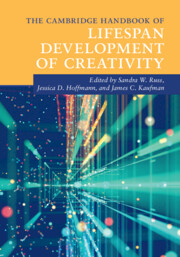Book contents
- The Cambridge Handbook of Lifespan Development of Creativity
- The Cambridge Handbook of Lifespan Development of Creativity
- Copyright page
- Dedication
- Contents
- Figures
- Tables
- Contributors
- Acknowledgments
- Introduction
- Part I Core Concepts of Lifespan Creativity Development
- Part II The Development of Creativity
- 5 Are Preschoolers Creative?
- 6 Development of Creativity in School-Age Children
- 7 The Development and Enhancement of Adolescent Creativity
- 8 The Intertwined Development of Identity and Creativity
- 9 Creative Development in Children from a Measurement Perspective
- 10 Creativity in Adulthood
- 11 The Many Faces of Creativity in Old Age
- Part III Modes of Enhancement
- Part IV Environments and Contexts
- Part V Special Populations
- Index
- References
6 - Development of Creativity in School-Age Children
from Part II - The Development of Creativity
Published online by Cambridge University Press: 19 November 2021
- The Cambridge Handbook of Lifespan Development of Creativity
- The Cambridge Handbook of Lifespan Development of Creativity
- Copyright page
- Dedication
- Contents
- Figures
- Tables
- Contributors
- Acknowledgments
- Introduction
- Part I Core Concepts of Lifespan Creativity Development
- Part II The Development of Creativity
- 5 Are Preschoolers Creative?
- 6 Development of Creativity in School-Age Children
- 7 The Development and Enhancement of Adolescent Creativity
- 8 The Intertwined Development of Identity and Creativity
- 9 Creative Development in Children from a Measurement Perspective
- 10 Creativity in Adulthood
- 11 The Many Faces of Creativity in Old Age
- Part III Modes of Enhancement
- Part IV Environments and Contexts
- Part V Special Populations
- Index
- References
Summary
The school-age years are an important period for the development of creativity. Children 6–12 years of age must learn to balance creative thinking with the conventional demands of parents, schools, and society. The development of components of creative thinking should be focused on in research. Divergent thinking is one component that is a valid indicator of creative potential. Much of the research on the developmental trajectory of divergent thinking has found contradictory results. Moderators such as type of task and culture are factors to take into account. Pretend play is also a common form of creative activity during these years that includes many of the components of creativity. Implications of research findings are discussed.
- Type
- Chapter
- Information
- The Cambridge Handbook of Lifespan Development of Creativity , pp. 126 - 138Publisher: Cambridge University PressPrint publication year: 2021



